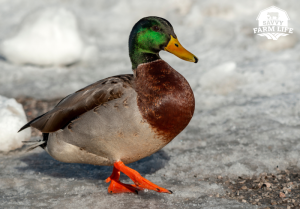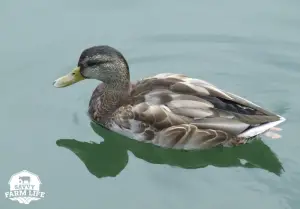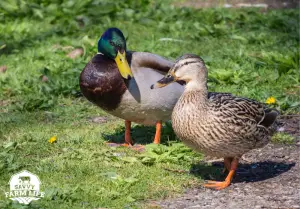How Ducks Mate
Ducks are unlike most other birds in both mating behaviors and reproductive anatomy. If you are interested in watching your ducks hatch new ducklings this Spring, you will want to familiarize yourself with how ducks mate.
How do ducks mate? While the act of mating in ducks is similar to that of other birds, the reproductive anatomy of a duck is unique among the avian species, having evolved as a result of their unusual mating and social behaviors. Duck mating is arguably one of the most aggressive in the animal kingdom, and is forced upon the female ducks a relatively large percentage of the time.
Whether you are interested in learning more about duck reproductive behavior because you are preparing for your own ducklings, or simply because you have heard about the seemingly brutal behavior, read on to learn everything (and more) you want to know about duck mating.
Understanding How Ducks Mate
Consensual mating among ducks is similar to that of many other birds. In the wild, the males outnumber the females and so they must compete for attention. Drakes will strut around the females, making themselves look large and impressive, and will bob their heads up and down. Once a female accepts a male as a mate, the drake will mount her from behind. The female, receptive to the drake, will relax her muscles and will pull her tail feathers to the side. The drake will hold the female’s neck with his bill to steady himself. Once they are in the optimal position for insemination, and not prior, the male’s sex organ will “explode” out of his body and into the female’s in the blink of an eye.
Because ducks will mate for the season, the same drake will stick around and mating can occur multiple times over this period to ensure success. If a female lays her eggs and then loses them (to a predator, for example), she will usually mate again with the same drake, giving her another chance.
While ducks can certainly mate on land, they prefer to mate in the water as this is where they feel less vulnerable. While the drake “pins” the female duck for intercourse, he will push her head under the water to stabilize their bodies. Because of this, a female duck can be drowned during mating if a drake is particularly aggressive, or if there are multiple drakes attempting to mate with the same female.
Forced Mating Among Ducks
One of the reasons that ducks have a reputation for being particularly aggressive during mating is because of the high prevalence of forced matings. It is estimated that up to ⅓ of mating encounters among ducks are not consensual. Drakes (often multiple drakes consecutively) will force themselves onto female ducks. Not only is this unpleasant for the females, but it increases the chance of injury or even death as a result of the aggressive tactics.
While one may assume that it is the unpaired drakes who are perpetrating these forced acts most of the time, the opposite is true. Unpaired drakes are busy, spending most of their time attempting to garner the attention of unpaired females. While a female duck is sitting on a brood or otherwise occupied however, paired drakes will wander off for short periods of time. It is during these times that a paired drake will force himself upon another female, before hurrying back to his mate to protect her (from other philandering drakes like himself).
What is a female to do in these situations? The only thing that she can do is adjust her position slightly so that the unwanted drake’s sperm enters one of the false pockets in her vaginal canal. In research of duck mating, biologists have learned that 90% of forced encounters do not result in fertilization. The female has the innate ability to direct the unwanted sperm into a dead-end, where it will be naturally expelled shortly after the encounter.
Do Ducks Mate For Life?
Unlike other waterfowl such as geese and swans, ducks do not mate for life. When living naturally in the wild, however, they will mate for a season. Male ducks (drakes) will start the breeding season off by trying to impress the females, and because there are more drakes than female ducks in the wild (drakes make up 55-70% of the population, depending on breed), females have the final say in with whom they partner up.
Once a pair has been established, the drake will mate with the female and will stick around to protect her from other males. While this allows the female to focus on preparing for her brood, it also ensures that the sperm of other males cannot infiltrate the upcoming batch of eggs. After the eggs have hatched, the female will raise them on her own as the drake spends less and less time with her until he eventually moves on completely in the Fall.
The Unique Reproductive Anatomy Of The Duck
In order to understand what is so unique about duck mating, we have to discuss the fascinating reproductive organs of both male and female ducks. 97% of the avian species have cloacas for reproductive organs – these are body cavities that are used for both mating and waste elimination, and found in both males and females. Male birds have testicles, of course, and females have ovaries, but these are housed internally.
Ducks and other waterfowl are unique among birds as they have penises and vaginal cavities instead of cloacas. While the fact that they have these organs might cause you to believe they mate more similarly to other mammals, the organs themselves are very different from other species. One of the unique attributes is that both male and female organs have a corkscrew shape, with ridges spiraling clockwise (in female ducks) and counter-clockwise (in drakes). Why they spiral in opposite directions is unknown, with biologists currently at a loss as to the advantage this can give them.
Reproductive Organs Of The Male Duck 
The drake’s penis is housed internally, making an appearance only during intercourse. It is shaped like a corkscrew, with a counter-clockwise spiral, and can reach up to 20 centimeters (that’s over 7 inches) in length. What’s even more fascinating is the fact that they are described to have “explosive erections” – with the penis exiting its internal housing and penetrating fully into the female duck in ⅓ of a second. This trait may have evolved due to the challenges of mating in the water, where every second (or ⅓ of a second) counts.
Why do drakes and other male waterfowl have penises instead of the cloaca that most other birds possess? While it can’t be said with certainty, it is believed that waterfowl are equipped with external sex organs so that their sperm does not simply wash away in the water. This theory seems to hold water (yes, pun intended) as waterfowl do tend to prefer mating in the water as opposed to on land.
Interestingly, scientists have determined in their research of avian embryos that all male birds develop a penis – shortly after development, a gene known as Bmp4 activates to kill these specific cells, causing the developing organ to wither away.
Reproductive Organs Of The Female Duck 
It may be hard to believe, but it can be argued that the female duck’s reproductive anatomy is even more fascinating than the drake’s. Females have a long vaginal canal, also corkscrew-shaped, but with clockwise spirals. Why the sex organs of males and females spiral in opposing directions remains a mystery, but some researchers theorize it can aid in communication between the sexes during mating. Others believe the female’s vaginal canal has evolved into a hostile environment (more on this below) and the opposing spirals are simply another example of this.
There is another unique attribute to the female’s vagina – it is home to several “false pockets” – these are literally pockets that stem from the vagina and quickly dead-end. It is believed that females, by adjusting their position during intercourse, can send sperm into these dead-ends instead of to their eggs. Why would they want to do this? Duck mating is notorious for often being non-consensual, and females use their anatomy as a way to block the sperm of offending drakes.
Is Duck Mating Brutal?
Reading about how ducks mate can be disturbing. What we have to remember is that ducks are not humans, and attributing human characteristics and culture onto animals gives us a skewed perspective of the animal kingdom. Reproductive behavior in almost all animals (including humans) has evolved to give the species the best chance of survival.
How the seemingly brutal reproductive behaviors of ducks helps the species to endure might not be immediately clear to humans, but no one can say that their tactics are ineffective – after all, specific breeds of duck are so good at procreating they are considered invasive in many regions. So while you may not want to watch the romantic displays of your ducks, try not to worry – whatever they are doing seems to be working for them as a species.
If you’re thinking about owning or breeding ducks, you can learn more about them in the articles I’ve written below!

